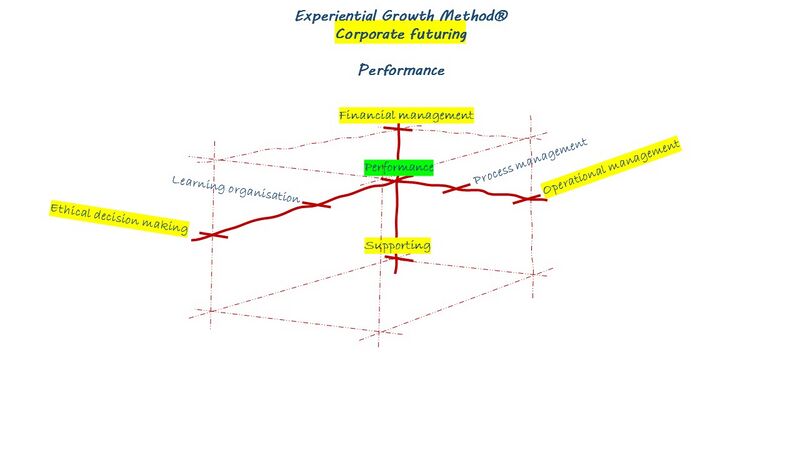Performance
Chapter 3 - Experiential Growth Method® - Deeper dive - Action field
Back to Action fields or Book content
.
Welcome to the Performance page
.
What is performance?
The accomplishment of a given task measured against preset known standards of accuracy, completeness, cost, and speed. In a contract, performance is deemed to be the fulfillment of an obligation, in a manner that releases the performer from all liabilities under the contract.
Business Performance Management
A business management approach which looks at the business as a whole instead of on a division level. Business performance management entails reviewing the overall business performance and determining how the business can better reach its goals. This requires the alignment of strategic and operational objectives and the business' set of activities in order to manage performance. Because Business Performance Management seeks to aggregate available information, managers are more informed about the company's position and are able to make better decisions.
.
Thinking about the concept
A visual thesaurus search is always an excellent starting point to discuss a concept definition:
| PERFORMANCE |
|---|
| https://www.freethesaurus.com/performance |
.
.
Relations of Performance within Corporate futuring (and Organisational futuring)
.
.
There exists a close vertical relationship within Corporate futuring:
- Outer focus: Financial management
- Other focus: Performance
- Inner focus: Supporting
.
On the Other focus level, a close relationship exists with:
- Operational management
- Ethical decision making
.
Corporate futuring and Organisational futuring intertwine, on the Other focus level, through:
- Learning organisation
- Process management
.
In concrete terms, this means:
- The trio - 'Supporting', 'Performance' and 'Financial management' - is inextricably linked.
- Your 'Performance' contributes substantially to 'Operational management' and 'Ethical decision making'.
- To realise your 'Operational management' through 'Performance', you need 'Process management'. Even so, to realise your 'Ethical decision making', you need a 'Learning organisation'.
.
Questions we can ask ourselves when contemplating our Performance
- Is our 'Performance' based on 'Supporting' our employees?
- Is our 'Financial management' in sync with our 'Performance'?
- Is our 'Performance' robust enough to generate a viable 'Operational management'?
- Is our 'Performance' keen enough to create financial flows?
- Or is our 'Performance' a collider or a mediator between Supporting and Financial Management?
- Or is our 'Performance' a collider or a mediator between our 'Ethical decision making' and our 'Operational management'?
.
.
Biases in Project management
| Name of Bias | Description |
|---|---|
| Strategic misrepresentation | The tendency to deliberately and systematically distort or misstate information for strategic purposes. Aka political bias, strategic bias, or power bias |
| Optimism bias | The tendency to be overly optimistic about the outcome of planned actions, including overestimation of the frequency and size of positive events and underestimation of the frequency and size of negative ones. |
| Uniqueness bias | The tendency to see one’s project as more singular than it actually is. |
| Planning fallacy | The tendency to underestimate costs, schedule, and risk and overestimate benefits and opportunities |
| Overconfidence bias | The tendency to have excessive confidence in one’s own answers to questions |
| Hindsight bias | The tendency to see past events as being predictable at the time those events happened. Also known as the I-knew-it-all-along effect. |
| Availability bias | The tendency to overestimate the likelihood of events with greater ease of retrieval (availability) in memory. |
| Base rate fallacy | The tendency to ignore generic base rate information and focus on specific information pertaining to a certain case or small sample |
| Anchoring | The tendency to rely too heavily, or “anchor,” on one trait or piece of information when making decisions, typically the first piece of information acquired on the relevant subject. |
| Escalation of commitment | The tendency to justify increased investment in a decision, based on the cumulative prior investment, despite new evidence suggesting the decision may be wrong. Also known as the sunk cost fallacy. |
| Source |
|---|
| Top Ten Behavioral Biases in Project Management: An Overview - Bent Flyvbjerg - Project Management Journal 2021, Vol. 52(6) 531–546 |
.
.
Performance indicators
Key Performance Indicators
Meaning
- Keep People Informed
- Keep People Involved
- Keep People Interested
- Keep People Inspired
.
Key PROCESS indicators
Process indicators refer to indicators to measure whether planned activities took place. Examples include, distribution, development, testing, etc.
.
Key Performance Indicators
.

